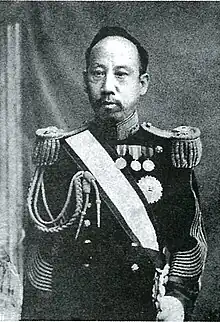Han Gyu-seol | |
|---|---|
| 한규설 | |
 | |
| Prime Minister of Korean Empire | |
| In office 27 August 1905 – 17 November 1905 | |
| Monarch | Gojong |
| Preceded by | Cho Byeong-ho |
| Succeeded by | Min Yeong-cheol |
| Personal details | |
| Born | 29 February 1856 Hanseong, Joseon |
| Died | 22 September 1930 (aged 74) Cheongju, North Chungcheong Province, Korea under Japanese rule |
| Resting place | Goyang, Gyeonggi Province |
| Other political affiliations | Independent politician |
| Military service | |
| Years of service | 1905–1907 |
| Rank | Lieutenant General |
Han Kyu-seol (Korean: 한규설; Hanja: 韓圭卨; 29 February 1856 – 22 September 1930) was a prime minister of Korean Empire when Japan–Korea Treaty of 1905 was signed. Han opposed the treaty, but failed to prevent it from being signed.
Life
Han was born on 29 February 1848 in Seoul. In his youth, Han passed the Gwageo's military examination,[1] and was appointed as the commander of army of the in Gyeongsang-right province.[2] After serving at various posts, Han was appointed as Mayor of Seoul in 1887. In 1896, Han was promoted to Minister of Law.[1]
When the Independence Club was formed, Han demonstrated favor for the liberal political party; he was appointed as the Speaker of the National Assembly when the People's Joint Association was at its peak.[1] To soothe the disgruntled public after arresting 17 leaders of the Independence club, Emperor Gojong appointed Han as the chief judge of the court. Han delivered the arrested leaders light punishments.[3] However as the Imperial government disbanded the Independence Club, Han was subsequently ousted from his position.[1]
After the proclaimation of the Korean Empire, Han served within various political posts. On 15 February 1902, Han was appointed as Minister of Law.[4] On 27 August 1905, Han was appointed as the prime minister,[5][6] and Lieutenant General of the army on 8 November 1905.[7] As the prime minister of Korea, Han firmly opposed the Eulsa Treaty.[1] Initially all of the ministers were against signing the treaty. Pak Chesoon, who was the Minister of Foreign Affairs, declared that he would rather commit suicide if Japan forced him to sign the treaty. However, when Han was locked in a closet at Jungmyeongjeon by Japanese troops and under threat of execution, the remaining ministers fearing similar treatment, signed the treaty. Ye Wanyong, Yi Ji-yong, and Gwon Jung-hyeon were the first to change their stance. After the Eulsa treaty was signed, Han made several attempts to annul the treaty but lacked the political power to do so, as he was previously dismissed from the position as prime minister.[8] After the treaty of 1905 was signed, Han, as well as Five Eulsa Traitors, were the target of public resentment. Choe Ik-hyeon wrote that Han was at great fault for the ratification of the treaty.[9]
After the annexation of Korea, Japanese Government gave Han title of Baron but he subsequently refused to accept it.[10] In 1920, Han established the Joseon Education Organization with Yi Sang-jae, which was later transformed into the Minrip Deahak Gisunghui. He died on 22 September 1930 in Cheongju City.[1]
On 17 March 1977, Han's house became officially recognized a cultural property within Seoul.[11]
Family
- Grandfather
- Father
- Han Seung-ryeol (한승렬, 韓承烈)
- Sibling(s)
- Older brother - Han Gyu-jik (한규직, 韓圭稷)
- Younger brother - Han Jin-ho (한진호)
- Unnamed wife
- Issue
- Son - Han Yang-ho (한양호, 韓亮鎬); founder of Seoul Girls' Commercial High School
- Daughter-in-law - Lady Jeong of the Yeonil Jeong clan (연일 정씨)
- Grandson - Han Hak-su (한학수, 韓學(?)); was chairman of the board of bachelor arts
- Daughter-in-law - Lady Jeong of the Yeonil Jeong clan (연일 정씨)
- Daughter - Lady Han of the Cheongju Han clan (청주 한씨, 淸州 韓氏)
- Son-in-law - Gwon Yeong-deok (권영덕) of the Andong Gwon clan (안동 권씨)
- Daughter - Lady Han of the Cheongju Han clan (청주 한씨, 淸州 韓氏)
- Son-in-law - Jo Man-gu (조만구) of the Pungyang Jo clan (풍양 조씨)
- Daughter - Lady Han of the Cheongju Han clan (청주 한씨, 淸州 韓氏)
- Son-in-law - Sim Gyu-seob (심규섭, 沈珪燮) of the Cheongsong Sim clan (청송 심씨)[12]
- Granddaughter - Sim Jae-sun (심재순, 沈載谆)
- Grandson-in-law - Yu Chi-jin (유치진, 柳致眞) (15 December 1905 - 10 February 1974); founder of Seoul Institute of the Arts
- Great-Granddaughter - Yu In-hyeong (유인형); was a professor in the Department of Theater at Seoul Institute of the Arts
- Great-Grandson - Yu Deok-hyeong (유덕형); was president and chairman of Seoul Institute of the Arts
- Grandson-in-law - Yu Chi-jin (유치진, 柳致眞) (15 December 1905 - 10 February 1974); founder of Seoul Institute of the Arts
- Granddaughter - Sim Jae-sun (심재순, 沈載谆)
- Son-in-law - Sim Gyu-seob (심규섭, 沈珪燮) of the Cheongsong Sim clan (청송 심씨)[12]
- Son - Han Yang-ho (한양호, 韓亮鎬); founder of Seoul Girls' Commercial High School
Honours
- Order of the Palgwae 1st Class
References
- 1 2 3 4 5 6 "한규설(韓圭卨) - 한국민족문화대백과사전". encykorea.aks.ac.kr. Retrieved 2022-03-21.
- ↑ "조선왕조실록". sillok.history.go.kr. Retrieved 2022-03-21.
- ↑ 신편한국사. "2) 독립협회 지도자 석방운동".
- ↑ "한국고전종합DB". db.itkc.or.kr. Retrieved 2022-03-21.
- ↑ "한국사데이터베이스". db.history.go.kr. Retrieved 2022-03-21.
- ↑ "한국고전종합DB". db.itkc.or.kr. Retrieved 2022-04-18.
- ↑ "조선왕조실록". sillok.history.go.kr. Retrieved 2022-03-21.
- ↑ "을사늑약 반대한 한규설 '회고담' 100년만에 발굴". 경향신문 (in Korean). 2005-11-14. Retrieved 2022-03-21.
- ↑ "한국고전종합DB". db.itkc.or.kr. Retrieved 2022-03-21.
- ↑ "116년 전 오늘, 비운의 '을사늑약' 현장 직접 가보니". 오마이뉴스 (in Korean). 2021-11-17. Retrieved 2022-03-21.
- ↑ "서울특별시 민속문화재 장교동한규설가옥 (長橋洞 韓圭卨 家屋) : 국가문화유산포털 - 문화재청". Heritage Portal : CULTURAL HERITAGE ADMINISTRATION (in Korean). Retrieved 2022-03-28.
- ↑ He was the youngest grandson of Sim Eung-taek (심응택, 沈應澤) and Lady Min of the Yeoheung Min clan. Lady Min was the youngest sister of Grand Internal Princess Consort Sunmok and aunt of Gojong of Korea.